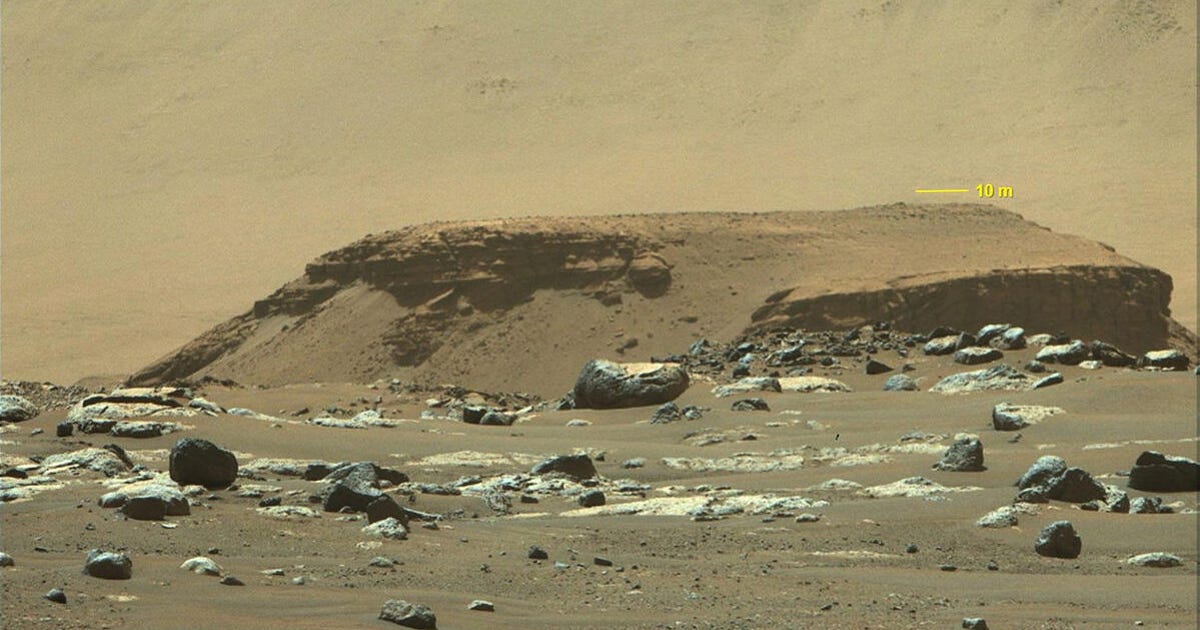Huge ancient lake on Mars traversed by NASA rover could be hiding fossilized signs of alien life

Perserverance’s view across the Jezero Crater toward the ancient river delta.
NASA/JPL-Caltech
Mars rovers may soon get a few new checkpoints to explore. Geologists say specific areas of an ancient river delta near where NASA’s Perseverance rover is stationed could hold fossilized evidence of extraterrestrial life.
Though they don’t expect to find any bug-eyed, green aliens, they do say vital organic compounds that suggest the presence of past life might exist there, waiting to be uncovered.
The crew of researchers behind the new study, published on Oct. 7 in the journal Science, dissected photographs taken by NASA’s recently landed Perseverance rover and uncovered ways that water flowed on Mars billions of years ago.
Their analysis unveiled spots on the arid orb that could house the highly sought-after biosignatures.
“We know that water was running on the surface at one point in the past, but we don’t know the duration of this activity,” said the study’s lead author, Nicolas Mangold, a geologist at the University of Nantes in France.
NASA’s Perseverance and the legend of Jezero
Once upon a time in space, Mars wasn’t a dry and dangerous world. It was covered in fresh rivers and lakes, a lot like those on Earth. And where there’s water, there could be life.
The vast bodies of H2O dried up eons ago as the formerly blue planet’s delicate atmosphere disappeared. This turned the environment into the inhospitable land we’ve come to know today.
Scientists have long been intrigued by the past existence of water on Mars. That’s why NASA sent Perseverance to traverse the planet in hopes of finding fingerprints of life. More specifically, they sent the rover to a huge crater called Jezero.

This Mars Reconnaissance Orbiter image shows the Jezero Crater delta region.
NASA/JPL-Caltech/MSSS/JHU-APL
Believed to have once been flooded by water, the Jezero crater houses an ancient river delta — a delta that could be holding signs of alien life.
Deltas are landforms generated by rock and sediment swept up by a river’s flow. That stream often carries organic molecules and bacteria in its path, which means Jezero’s delta could easily contain an accumulation of such materials.
In other words, it could contain fossilized building blocks of life.
With that in mind, the study team’s proposed points of interest for locating evidence of life on Mars are all anchored by that delta. Initially, Mangold says, he hoped Perseverance would catch clear images of the spot, but unfortunately, Percy is a bit too far from the old river for that.
“Despite our disappointment,” he said, “we tried to look at the delta from a distance using our best cameras, and that gave really wonderful results.”
Clues from Kodiak
Surprisingly, the researchers didn’t find the prized areas just by analyzing Jezero’s main delta. They observed a nearby butte, or mound of rock, dubbed Kodiak. Kodiak is a part of the delta that’s slightly farther away.
“You can imagine that the delta was a little bit extended to the south and to the east, then erosion removed some of the material,” said Mangold. “But Kodiak is, by miracle, preserved.”
Kodiak serves as a geologic representation of the main river delta’s features. The stratigraphy, its rock layers, is relatively easy to see from afar, according to the researchers.
“By understanding the stratigraphy at Kodiak, it enables us to identify the deposits which are the most likely of interest for life preservation,” Mangold said.
He described the team’s first look at the photos as a “shock.”
“The first image is actually [one] where we can see boulders,” he said. “A delta fault … is not supposed to get some big boulders. It’s supposed to be consistent.”
Those boulders, he said, mean Jezero’s river delta is what’s called a Gilbert-type delta. These are formed with stronger water flow such as waves and tides, like that found in a lake. Thus, the team believes the river’s flow suddenly grew more intense during the course of its life.
“A big question for us,” Mangold said, “is to understand why there was this change of hydrological activity, because that is probably the signature of a change of climate.”
Kodiak also offered insight into how high the ancient body of water rose. Mangold says it would’ve been about 8,202 feet (2,500 meters) high, based on striations of rocks in the butte. That elevation varied over time, he says, which is also consistent with the idea the river advanced into a lake.
“That kind of observation is really key,” he explained. “Because it shows that there was a lake in Jezero, no doubt about that … in addition, the change from horizontal bedding to the faults, which are deep in layers, indicates the past water level.”
In the end, all this knowledge led Mangold’s team to isolate places where remnants of life could be found — deeper layers of Kodiak that likely have mud-dominated residue as well as sand grains. These types of sediments have been known to contain organic, life-sustaining molecules.
“Kodiak is not easily accessible by the rover because it’s a bit vertical facing,” Mangold noted.
“But we have identified some locations on the main delta fault where we can access similar types of layers. Those locations are some of our preferred targets for future rover travels.”
For all the latest world News Click Here

